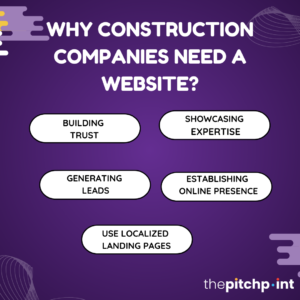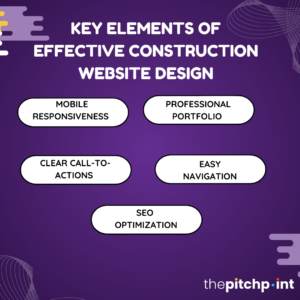Web Design for Construction
In an industry as hands-on as construction, your company’s web design is often the first impression clients get of your capabilities. As per stats, 38% of people will stop interacting with a poorly designed site. For construction companies, a professional, well-designed website isn’t just a “nice-to-have”—it’s a business necessity. With 38.5% of users judging a business by how its website looks at first glance, your construction company website is the most important sales tool.
A thoughtfully crafted construction company website can elevate your brand, showcase your portfolio, and turn website visitors into qualified leads. But it’s not just about good visuals. A high-performing website integrates essential features like project galleries, client testimonials, and clear calls to action, all while being mobile-friendly and optimized for local search. In this article, we’ll break down the key elements of a successful construction company website development and show how leveraging cutting-edge design and development can set your business apart in an increasingly competitive market.
Why Construction Companies Need a Web Design?

Having a construction company website is crucial to thrive in a competitive market. A professional online presence not only enhances visibility but also establishes credibility, helping businesses connect with potential clients and showcase their expertise.
-
Establishing Online Presence: Gain Visibility in a Competitive Market
In today’s digital age, having an online presence is crucial for construction companies to stay competitive. Potential clients often search for contractors, builders, and construction firms online before making a decision. A well-designed contractor website ensures that your company appears in search engine results and helps you reach a wider audience. With search engine optimization (SEO), your website can rank higher on platforms like Google, increasing your visibility and attracting more qualified leads.
-
Showcasing Projects and Expertise: Portfolio Sections for Completed Projects
A website provides the perfect platform to showcase your construction projects, from residential homes to commercial developments. Including a portfolio section allows you to display high-quality images and videos of your work, demonstrating your skills and expertise. Potential clients can review these projects, which serves as proof of your capabilities and experience. A well-organized portfolio that highlights key achievements also helps differentiate your company from competitors.
-
Building Trust: Testimonials, Client Reviews, and Certifications
Trust is a key factor when clients choose a construction company. Your website can serve as a hub for testimonials, client reviews, and certifications that demonstrate your reliability and professionalism. Including these elements builds credibility, assuring visitors that your company delivers on its promises. You can further strengthen trust by showcasing any industry affiliations or certifications that validate your expertise and adherence to standards.
-
Generating Leads: Using the Website as a Tool for Capturing Inquiries and New Business Opportunities
A construction company website is not just an informational resource; it’s a powerful lead-generation tool. By integrating lead capture forms, clear call-to-actions (CTAs), and contact options, you make it easy for potential clients to reach out for quotes, inquiries, or consultations. Keywords like “construction services near me,” “get a quote,” or “contact a builder” can be strategically placed to enhance your website’s visibility in local searches.
Additionally, contact forms allow you to collect vital information from visitors interested in your services, turning them into potential leads. You can also integrate CRM (Customer Relationship Management) systems to streamline follow-ups and manage client interactions. This approach not only attracts new clients but also increases conversions, turning your website into an active participant in your sales funnel.
By focusing on these core aspects, construction companies can leverage their website to attract clients, showcase their expertise, and capture valuable leads, all while enhancing their overall digital presence.
Key Elements of Effective Construction Web Design
Creating an impactful online presence in the construction industry starts with an effective website design. Key elements such as intuitive navigation, compelling visuals, and robust functionality are essential to attract and retain clients.
-
Mobile Responsiveness
Many potential clients in the construction industry access websites through mobile devices. A mobile-responsive design ensures that the website looks and functions seamlessly on smartphones, tablets, and desktops alike. This feature provides a positive user experience regardless of the device being used, which is critical for “on-the-go clients” such as project managers and contractors who may need quick access to services or contact information while on-site.
-
Professional Visuals and Portfolio
First impressions matter, especially in the construction industry, where the quality of work is often judged visually. A website should feature high-quality images and videos of completed projects to demonstrate the company’s expertise and capabilities. The portfolio section acts as a visual proof of the company’s professionalism and can help build trust with potential clients. Using before-and-after project visuals, 3D renders, or virtual tours can provide an immersive experience, showcasing craftsmanship in commercial construction, residential projects, or infrastructure development.
-
Clear Call-to-Actions (CTAs)
A construction company website must guide users to take action, whether it’s requesting a quote, scheduling a consultation, or downloading a brochure. Effective CTAs like “Get a Free Quote,” “Schedule a Consultation,” or “Request a Site Visit” should be prominently placed throughout the website. These CTAs ensure that users can easily engage with the business and increase lead generation. Actionable buttons in noticeable places—on the homepage, service pages, or portfolio pages—help turn visitors into clients.
-
Easy Navigation
A construction company website needs to have an ‘intuitive layout’ that allows visitors to quickly find key information. A simple, clean navigation menu that highlights essential sections like services, portfolio, and contact information helps visitors quickly locate what they need without frustration. This is especially important in the construction industry, where clients may want to immediately find details on a specific type of service, whether it’s general contracting, project management, or civil engineering. A well-structured sitemap and a search bar can further enhance the user experience.
-
SEO Optimization
For construction businesses to attract local and industry-specific clients, SEO optimization is crucial. This involves using location-based keywords (e.g., “construction company in [City Name]”) and industry-specific terms (e.g., “commercial building services” or “residential remodeling”) to ensure that the website ranks well on search engines like Google. By integrating these keywords naturally into page titles, meta descriptions, and content, the website can increase visibility to potential clients who are actively searching for construction services.
-
Security Features
A secure construction company website builds trust, particularly when handling client inquiries or project-related data. Implementing an SSL certificate ensures that the website encrypts sensitive information, such as contact forms or payment details. Other features, like secure contact forms, help prevent hacking or data theft, which is especially important in the construction industry, where sensitive project information or client data may be exchanged. Having visible security seals and trust badges also enhances credibility and encourages clients to interact with the website.

Best Practices for Web Design & Development in the Construction Industry
In the competitive construction industry, having a robust online presence is crucial for attracting clients and showcasing expertise. Adopting best practices in website development not only enhances user experience but also ensures that your website effectively meets the needs of your target audience.
-
Optimizing for Speed: Ensuring Fast Loading Times
Website speed is crucial, especially in the construction industry, where potential clients often seek quick information on services and past projects. A slow-loading site can deter visitors and lead to higher bounce rates. To optimize for speed:
– Minimize Image Sizes: Use compressed, high-quality images without sacrificing visual appeal. This is particularly important for displaying large project portfolios and high-resolution images.
– Enable Browser Caching: Store website elements in a user’s browser to reduce load time on repeat visits.
– Use Content Delivery Networks (CDN): Distribute website content globally to ensure fast access, regardless of user location.
– Minimize HTTP Requests: Reduce the number of elements on a page, like scripts and images, to lower loading times.
-
Mobile-First Design Approach: Cater to Both Desktop and Mobile Users
With an increasing number of users accessing websites via mobile devices, it’s essential to design with a mobile-first mindset. In the construction industry, clients and project managers are often on the go and need to quickly access site information from their phones. Mobile-first design ensures:
– Responsive Layouts: The website adjusts seamlessly to different screen sizes, providing an optimal viewing experience on both desktop and mobile devices.
– Clickable CTAs: Buttons and links are sized appropriately for mobile use, making it easy for visitors to request quotes, view project portfolios, or contact the company.
– Mobile-Friendly Navigation: Menus and navigation bars are simplified for easy access, ensuring users can find the information they need quickly.
-
Integration with CRM Systems: Streamlining Lead Management and Customer Inquiries
Integrating a Customer Relationship Management (CRM) system into a construction company’s website helps streamline communication and improve lead management. By automating the tracking of client inquiries and interactions, businesses can:
– Capture Leads Efficiently: Automatically store contact form submissions and inquiries, enabling quick follow-up with potential clients.
– Track Customer Interactions: Keep a record of conversations, project details, and client needs in one place.
– Improve Customer Experience: Automate responses, schedule follow-ups, and ensure no lead is overlooked.
CRM integration allows construction companies to manage a higher volume of inquiries without sacrificing personalization or quality of service.
-
Maintenance and Updates: Ensuring the Site Stays Relevant and Up-to-Date with the Latest Projects
Regular website maintenance is essential for keeping the site secure, functional, and reflective of the latest projects and services. Construction companies should focus on:
– Updating Project Portfolios: Continuously add new projects, update client testimonials, and showcase recent work to demonstrate the company’s growth and success.
– Security Patches and Plugin Updates: Keep the website safe from cyber threats by updating CMS platforms, plugins, and security certificates.
– Fixing Broken Links: Regularly check for and fix any broken links to maintain a seamless user experience.
– Content Refresh: Ensure that blogs, service pages, and other content are relevant and reflect current industry trends, new services, or regulations.
Technologies and Tools for Building Construction Websites
Building a robust and visually appealing website for the construction industry requires leveraging the latest technologies and tools. These innovations ensure the site is not only functional and responsive but also capable of effectively showcasing projects and engaging clients. Here are key technologies:
-
Content Management Systems (CMS)
- WordPress: The most popular CMS, WordPress offers flexibility and ease of use, allowing construction companies to manage and update their web design & website content with minimal technical knowledge. With a vast array of construction-specific themes and plugins, it’s ideal for building responsive, SEO-friendly websites that showcase project portfolios, team information, and client testimonials.
- SEO Optimization: WordPress have built-in SEO capabilities and can be enhanced with plugins to help construction websites rank higher in search engine results, particularly for local construction services.
-
Custom Web Design & Development Solutions
- Tailored Features: For construction companies with unique business requirements, custom web design & development allows complete control over the design and functionality of the site. This could include tailored project management systems, client portals, or custom booking and inquiry forms. By building a custom solution, developers can ensure that the website aligns perfectly with the company’s branding and specific operational needs.
- Scalability: As construction companies grow, custom solutions can be easily expanded, adding new features such as additional service areas, real-time project tracking, or client collaboration tools without the constraints of pre-built CMS themes or plugins.
-
Integrating 3D Models and Virtual Tours
- 3D Visualization: Integrating 3D models allows construction companies to showcase detailed project designs, helping clients visualize the final result before construction even begins. This is particularly useful for high-value commercial projects, home builders, and architects. These models can be integrated into the website using tools like SketchUp or AutoCAD, allowing clients to interact with designs directly from the website.
- Virtual Tours: Virtual tours can be implemented to showcase completed projects or properties under development. This technology gives potential clients an immersive experience, allowing them to explore different areas of a site or building remotely. It’s an innovative way to build engagement and provide transparency about the company’s work.
-
Integration with Project Management Tools
- Client Communication: Integrating project management tools such as Procore, Builder-trend or Co-Construct into a construction website allows for seamless communication between the construction team and clients. These tools provide a centralized hub for updates, timelines, and project status, reducing the need for constant back-and-forth emails or calls.
- Real-time Project Tracking: Offering clients access to real-time project tracking through the website enhances transparency and trust. This feature can show live updates on project milestones, budgets, and schedules. Additionally, integration with internal tools like Trello or Asana can streamline workflows for the construction team, helping to manage tasks and timelines efficiently.
Endnote
In conclusion, having a well-designed and functional web design is no longer optional for construction companies—it’s a necessity in today’s digital landscape. A professional website not only showcases your expertise and past projects but also establishes trust, generates leads, and helps you stay competitive. By integrating essential features like a project portfolio, testimonials, and intuitive navigation, your website can act as a powerful tool for business growth. Construction companies that invest in a responsive, secure, and optimized web presence are better positioned to attract clients, manage projects more efficiently, and ultimately drive success in an ever-evolving industry. Now is the time to elevate your construction business with a website that reflects your professionalism and commitment to quality.
Contact Thepitchpoint for custom web development solutions for construction company!

